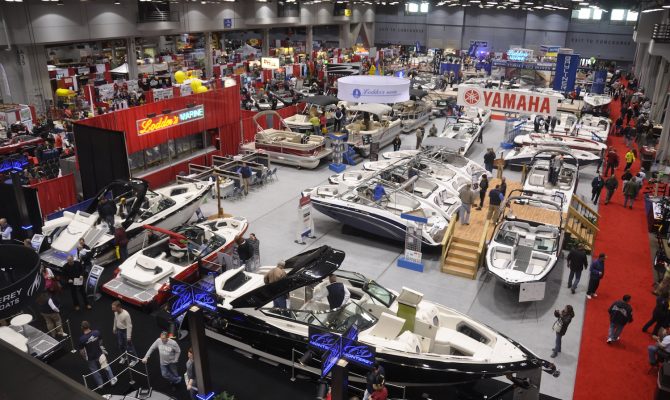Do Your ‘Presearch’
Back at the boat show, when you sealed the deal on your purchase and surrendered your deposit, you were probably presented with a stack of materials and manuals offered by the manufacturer of the boat and the motor you just ordered. If you haven’t yet done so, now is the time to buckle down and study the material, with a pen and paper handy to note the questions you’ll have about the operation and care and maintenance of the boat, motor and associated gear.
And if he hasn’t offered and arranged it already, you’ll also want to get back to your dealer and request a thorough bow-to-stern walkthrough and a demo (or “shakedown”) cruise to confirm that everything works as advertised before you officially accept delivery. This also gives you the chance to learn first-hand how to operate the vessel and properly use each of the accessories aboard. And to explain why he may not be giving the boat full throttle.
Breaking In the Engine
That’s because one of the most important, and oft-overlooked, tasks that new boat owners should undertake is the proper breaking in of the engine. Following the recommended break-in procedure for your boat’s motor is perhaps the most important thing you can do to get the best performance and longest life out of your engine. That usually means running the engine at moderate speeds for the first several hours. Some new diesels should first be run at moderate speed and under load — and not at idle — for a certain number of hours to properly break them in.
Most manufacturers also specify mandatory service after a few hours of operation. In the case of diesel and/or some four-stroke engines, oil contamination during the break-in period is a threat and requires early filter and lubricant changes to remove impurities and make sure that clean, fresh lubricants are flowing through the engine.
And if you think you can miss some of these critical procedures without the manufacturer knowing about it when it goes in for service, think again. Most modern engines operate using Electronic Control Modules (ECMs) that keep track of critical operation information that will show up on the service technician’s diagnostic computer, and any lapses may void the warranty.
Drive System
If you have transitioned from an outboard or sterndrive model and your new boat is powered by an inboard engine there may be a bit of a learning curve. Alignment and initial lubrication of outboards and sterndrives is a simpler, more straightforward process. On the other hand, inboard engines and their transmissions deserve attention from the time of delivery, and at regular intervals throughout their service, that owners of outboards and sterndrives may not be familiar with.
The hydraulically operated gear mechanisms of inboards are lubricated using separate pumps, filters and reservoirs, and those fluids and filters need to be checked and changed on a regular basis. Precise alignment of the drive system is also important to minimize vibration and wear. The initial alignment is performed at the factory, usually with the boat out of the water. The alignment should be re-checked and set at the dealer after the boat is launched, and demonstrated to your satisfaction.
You should also inspect the sealing system where the propeller shaft passes through the hull and ask how to check and maintain that critical area, which, by the way, may also be served by a separate lubricant reservoir. Be sure to take notes as your dealer walks you through and explains this stuff!
Water Systems
It’s important that you know how to keep water out of your new boat, as well as in it, when needed. Check all through-hull connections to make sure they’re watertight and test the water pumps — including bilge, livewell and those feeding galleys, heads and shower systems — with the dealer to make sure they’re functioning and to learn how to clean the filters for each.
Ask the dealer if he/she vacuumed the bilge to remove any debris left behind from the construction process; small pieces of fiberglass or foam, dabs of adhesive, pieces of tape, and plastic filings from drilled holes that were not swept up can work their way into the bilge ump and clog it. Even if the manufacturer cleaned up at the boat’s completion, debris can shake loose during the transport process and require another vacuuming before the boat is water-ready.
Electrical Systems
Chances are good that your new boat will offer some new features with which you may not be familiar. This is especially true with navigation systems incorporating GPS and sonar, as well as autopilot setups and VHF radios, which are ever-changing.
In addition to getting a clinic on the new marine electronics on board, have the dealer review every switch and its function, including fuses or breakers, and how to reset each. Make sure all the navigation lights are working and that you know how to control them. Review the main electrical panel with the dealer; a notepad will come in especially handy to take notes at this point, and you may even want to record the process using photos or video, to document what can be a complex process for later reference.
Ground Tackle, Safety Gear & PFDS
You want to make sure the new boat is equipped with the proper ground tackle — and backup anchor and rode — to allow it to be securely anchored. If the boat comes with a power windlass, make sure you know how to use it. The same goes for lines and fenders; you want to make certain you have the right lengths and sizes for a secure hold at the dock. Finally, check to see there are the required types and numbers of PFDs, fire extinguishers and emergency signaling devices aboard.
Practice Makes Perfect
After signing off on the sale and taking delivery of your new boat, practice all the procedures shown to you by the dealer in a controlled situation until you’re confident in your ability to do so while on the open water. Learn to use as many of the onboard features as possible and review the electronics while the boat is at dock. Practice docking and slow-speed maneuvering, and launching and loading if it’s a trailerable boat, on a weekday when there’s less boat traffic and peer pressure, and more room and time to accommodate the errors you’re sure to make as you learn to master your new vessel. And don’t forget to have fun with it!
Author: Dan Armitage is a regular contributor to HeartLand Boating




